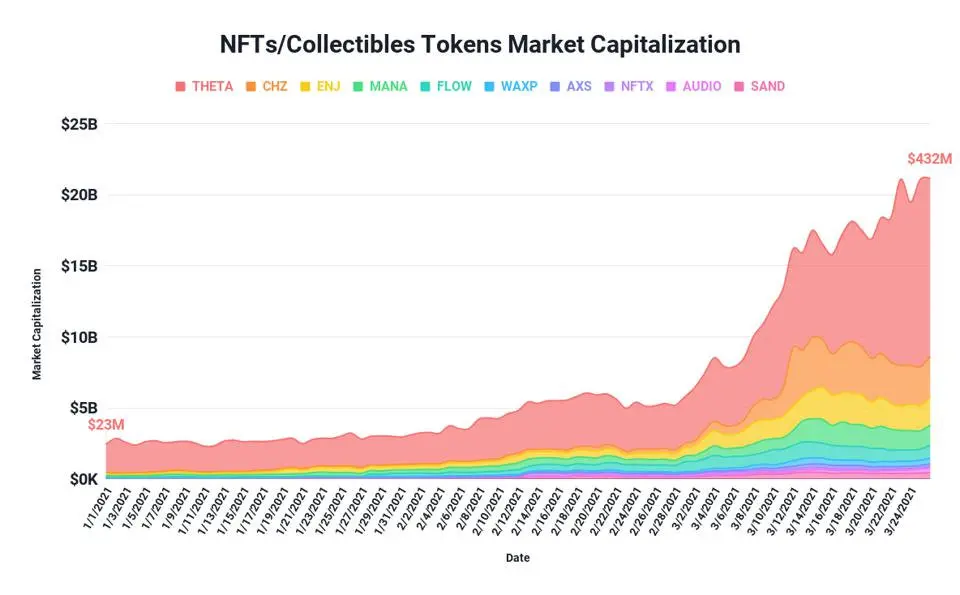How Nonfungible Tokens Are Introducing a New Digital Economy
During 2020’s watershed moment for decentralized finance, the non-fungible token industry (NFT) erupted. NFTs are digital representations of physical assets, such as art or real estate. These tokens are unique due to the inability to replicate them.
The NFT sector has seen expansive growth due to the relative efficiency of buying and selling tokens, as well as the reduced probabilities of fraud.
According to research from analytics platform DappRadar, NFT trading volume increased to $10.67 billion in the third quarter of 2021. This is a 704% rise over the previous quarter.
What Are NFTs?

NFTs are digital assets that represent real-world items. NFTs are non-fungible, meaning that they cannot be replicated. For example, if someone lends you $20, you don’t need to repay the exact $20 bill to complete the loan transaction. This is because that money is replaceable by any other $20 bill that holds the same value.
This also applies to the crypto sphere. For instance, Bitcoin has 21 million identical tokens that can all equally be traded for another. Conversely, NFTs for a specific work of art can only represent that particular item and are not equally tradable. For instance, if you buy one of a kind artwork, that item is irreplaceable and unique – it cannot be equally traded for another work of art.
The domain of NFT is still relatively young. In principle, NFTs may be used for anything that is unique and requires verifiable ownership. Here are some current examples of NFTs:
Digital Art
- GIFs
- Collectibles
- Music
- Videos
Real-World Items
- Deeds to a car
- Tickets to an event
- Tokenized invoices
- Legal documents
- Signatures
The Rise of NFTs
NFTs first caught the attention of the mainstream crypto community with the launch of CryptoPunks. A CryptoPunk is a 24×24 pixel, 8-bit style avatar that is offered as an NFT. A pair of developers utilized software to create 10,000 unique avatars on the Ethereum platform.
Ethereum is an open software platform that acts as a public ledger for validating and recording crypto transactions on a blockchain network. Users of the network may build, post, sell, and utilize apps on the platform using Ether, the network’s cryptocurrency. Experts refer to the network’s decentralized apps as “dApps.”
The popularity of CryptoPunks was in large part due to its novelty in the NFT realm. No two avatars are alike, and each avatar can officially be owned by one person. The limited quantity and single ownership of CryptoPunks increased its popularity and desirability.
Additionally, some avatars are rarer than others, increasing their value. The cheapest of these avatars starts at 100 ethereum, or $400,000. However, several CryptoPunks have sold upwards of millions of dollars.
Since then, numerous NFT platforms and innovative application cases have emerged in various industries.
The Many Uses
As a culture, we tend to value and gather things. So, the fact that NFTs have been used in a variety of contexts isn’t unexpected.
In 2017, Ethereum launched its collectible game, CryptoKitties. Unlike traditional games, CryptoKitties allows in-game assets to be tokenized, providing true ownership. As a result, players can collect and exchange weapons, vehicles, and characters as NFTs.
Aside from art, real-world collectibles can also be tokenized, stored, and transferred while retaining proof of authenticity and ownership. Designers and filmmakers, for example, can protect their work from copyright infringement by registering their work and even receiving ongoing royalties.
When purchased, NFTs are tracked through the blockchain, allowing royalties to flow back to the creator each time the digital asset is sold. As a result, growth in the NFT space has the potential to open a slew of new revenue streams. In addition to these examples from the gaming, art, and collectibles industries, proponents of NFT technology have cited a variety of other applications, ranging from introducing people to finance to combating fake news.
For example, the Italian blockchain firm LKS has created an NFT that can aid in limiting fake news and protecting digital content copyrights. The NFT is designed to include the identity of the publisher, the publishing time, and the original link. Similar to other blockchains, the information contained within cannot be edited or changed. As a result, it is easy to detect data that has been forged or altered from the original.
What’s Next?
For those who are unfamiliar with blockchain or cryptocurrency, the world of NFTs remains indeed very intricate. Both the public and the mainstream media have many misapprehensions about NFTs. Building decentralized apps for NFTs can be difficult, and it can be hard to emulate the same “feeling” as standing before a physical commodity in the digital realm.
However, among the earliest forms of NFTs were organizations tokenizing and monitoring supply chain products to increase security and reduce fraud. NFTs can significantly improve inventory management, software licensing, and even identity management in the enterprise, such as corporate entities using NFTs to record and confirm credentials. It will be intriguing to see how NFTs develop and, as its customer base expands, how different industries will incorporate and create new uses for NFTs.
NFTs have already had a massive effect, unleashing new digital economies, raising the cash flow of traditionally illiquid items, and altering our perception of asset ownership.



